Tetrarchy
The Tetrarchy is the term adopted to describe the system of government of the ancient Roman Empire instituted by Roman Emperor Diocletian in 293, marking the end of the Crisis of the Third Century and the recovery of the Roman Empire. The government of the empire was divided between the two senior emperors, the augusti, and their juniors and designated successors, the caesares.
| Roman imperial dynasties | |||
| The Tetrarchy | |||
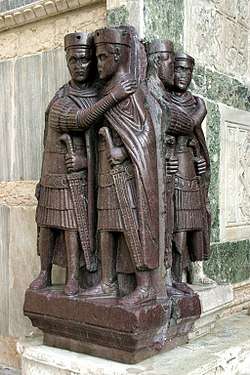 Portrait of the Four Tetrarchs, two porphyry sculptures looted from the Philadelphion of Constantinople after 1204, now standing at the southwest corner of St Mark's Basilica, Venice | |||
| Chronology | |||
| Diocletian as Augustus | 284–286 | ||
| -with Maximian as Augustus of the West |
286–293 | ||
| -with Galerius and Constantius Chlorus as Caesares |
293–305 | ||
| Maximian as the sole Caesar | 285–286 | ||
| -with Diocletian as Augustus of the East |
286–305 | ||
| -with Galerius and Constantius Chlorus as Caesares |
293–305 | ||
| Galerius and Constantius Chlorus as Caesares | 293–305 | ||
| Galerius and Constantius Chlorus as Augusti of East and West | 305–306 | ||
| -with Severus and Maximinus Daia as Caesares | 305–306 | ||
| Galerius and Severus as Augusti of East and West | 306–307 | ||
| -with Maximinus Daia and Constantine the Great as Caesares | 306–307 | ||
| Galerius and Maxentius as Augusti of East and West | 307–308 | ||
| -with Maximinus Daia and Constantine the Great as Caesares | 307–308 | ||
| Galerius and Licinius as Augusti of East and West | 308–311 | ||
| -with Maximinus Daia and Constantine the Great as Caesares | 308–311 | ||
| Maxentius as usurper in Rome (and Asia Minor 311–312) | 308–312 | ||
| Maximinus Daia and Licinius as Augusti of East and West | 311–312 | ||
| -with Constantine the Great as Caesar (self-proclaimed Augustus) | 311–312 | ||
| Licinius and Constantine the Great as Augusti of East and West | 312–324 | ||
| -with Licinius II and Constantine II, Crispus as Caesares | 317–324 | ||
| Succession | |||
| Preceded by Crisis of the Third Century |
Followed by Constantinian dynasty | ||
 |
|---|
| This article is part of a series on the politics and government of ancient Rome |
| Periods |
|
| Roman Constitution |
| Precedent and law |
|
|
| Assemblies |
| Ordinary magistrates |
| Extraordinary magistrates |
| Titles and honours |
Initially Diocletian chose Maximian as his caesar in 285, raising him to co-augustus the following year; Maximian was to govern the western provinces and Diocletian would administer the eastern ones. The role of the augustus was likened to Jupiter, while his caesar was akin to Jupiter's son Hercules. Galerius and Constantius were appointed caesares in March 293. Diocletian and Maximian retired on 1 May 305, raising Galerius and Constantius to the rank of augustus. Their places as caesares were in turn taken by Valerius Severus and Maximinus Daia.
The orderly system of two senior and two junior emperors endured until Constantius died in July 306, and his son Constantine was unilaterally acclaimed augustus and caesar by his father's army. Maximian's son Maxentius contested Severus's title, styled himself princeps invictus, and was appointed caesar by his retired father in 306. Severus surrendered to Maximian and Maxentius in 307. Maxentius and Constantine were both recognized as augusti by Maximian that same year. Galerius appointed Licinius augustus for the west in 308 and elevated Maximinus Daia to augustus in 310.
Constantine's defeat of Maxentius at the Battle of the Milvian Bridge in 312 left him in control of the western part of the empire, while Licinius was left in control of the east on the death of Maximinus Daia. Constantine and Licinius jointly recognized their sons – Crispus, Constantine II, and Licinius II – as caesares in March 317. Ultimately the tetrarchic system lasted until c. 324, when mutually destructive civil wars eliminated most of the claimants to power: Licinius resigned as augustus after the losing the Battle of Chrysopolis, leaving Constantine in control of the entire empire.
The Constantinian dynasty's emperors retained some aspects of collegiate rule; Constantine appointed his son Constantius II as another caesar in 324, followed by Constans in 333 and his nephew Dalmatius in 335, and the three surviving sons of Constantine in 337 were declared joint augusti together, and the concept of the division of the empire under multiple joint emperors endured until the Fall of the Western Roman Empire. In the Eastern Roman empire, augusti and caesares continued to be appointed sporadically.
Terminology
The term "tetrarchy" (from the Greek: τετραρχία, tetrarchia, "leadership of four [people]")[lower-alpha 1] describes any form of government where power is divided among four individuals.
Although the term "tetrarch" was current in antiquity, it was never used of the imperial college under Diocletian. Instead, the term was used to describe independent portions of a kingdom that were ruled under separate leaders. The tetrarchy of Judaea, established after the death of Herod the Great, is the most famous example of the antique tetrarchy. The term was understood in the Latin world as well, where Pliny the Elder glossed it as follows: "each is the equivalent of a kingdom, and also part of one" (regnorum instar singulae et in regna contribuuntur).[1]
As used by the ancients, the term describes not only different governments, but also a different system of government from the Diocletianic arrangements. The Judaean tetrarchy was a set of four independent and distinct states, where each tetrarch ruled a quarter of a kingdom as they saw fit; the Diocletianic tetrarchy was a college led by a single supreme leader. When later authors described the period, this is what they emphasized: Ammianus had Constantius II admonish Gallus for disobedience by appealing to the example in submission set by Diocletian's lesser colleagues; his successor Julian compared the Diocletianic tetrarchs to a chorus surrounding a leader, speaking in unison under his command.[2] Only Lactantius, a contemporary of Diocletian and a deep ideological opponent of the Diocletianic state, referred to the tetrarchs as a simple multiplicity of rulers.[3]
Much modern scholarship was written without the term. Although Edward Gibbon pioneered the description of the Diocletianic government as a "New Empire", he never used the term "tetrarchy"; neither did Theodor Mommsen. It did not appear in the literature until used in 1887 by schoolmaster Hermann Schiller in a two-volume handbook on the Roman Empire (Geschichte der Römischen Kaiserzeit), to wit: "die diokletianische Tetrarchie". Even so, the term did not catch on in the literature until Otto Seeck used it in 1897.[4]
Creation
The first phase, sometimes referred to as the diarchy ("rule of two"), involved the designation of the general Maximian as co-emperor—firstly as Caesar (junior emperor) in 285, followed by his promotion to Augustus in 286. Diocletian took care of matters in the eastern regions of the empire while Maximian similarly took charge of the western regions. In 293, Diocletian thought that more focus was needed on both civic and military problems, so with Maximian's consent, he expanded the imperial college by appointing two Caesars (one responsible to each Augustus)—Galerius and Constantius Chlorus.[5]
In 305, the senior emperors jointly abdicated and retired, allowing Constantius and Galerius to be elevated in rank to Augustus. They in turn appointed two new Caesars—Severus II in the west under Constantius, and Maximinus in the east under Galerius—thereby creating the second Tetrarchy.
Regions and capitals
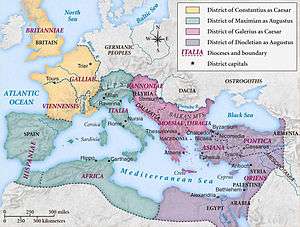
The four tetrarchs based themselves not at Rome but in other cities closer to the frontiers, mainly intended as headquarters for the defence of the empire against bordering rivals (notably Sassanian Persia) and barbarians (mainly Germanic, and an unending sequence of nomadic or displaced tribes from the eastern steppes) at the Rhine and Danube. These centres are known as the tetrarchic capitals. Although Rome ceased to be an operational capital, Rome continued to be nominal capital of the entire Roman Empire, not reduced to the status of a province but under its own, unique Prefect of the City (praefectus urbi, later copied in Constantinople).
The four tetrarchic capitals were:
- Nicomedia in northwestern Asia Minor (modern Izmit in Turkey), a base for defence against invasion from the Balkans and Persia's Sassanids was the capital of Diocletian, the eastern (and most senior) Augustus; in the final reorganisation by Constantine the Great, in 318, the equivalent of his domain, facing the most redoubtable foreign enemy, Sassanid Persia, became the pretorian prefecture Oriens, 'the East', the core of later Byzantium.
- Sirmium (modern Sremska Mitrovica in the Vojvodina region of modern Serbia, and near Belgrade, on the Danube border) was the capital of Galerius, the eastern Caesar; this was to become the Balkans-Danube prefecture Illyricum.
- Mediolanum (modern Milan, near the Alps) was the capital of Maximian, the western Augustus; his domain became "Italia et Africa", with only a short exterior border.
- Augusta Treverorum (modern Trier, in Germany) was the capital of Constantius Chlorus, the western Caesar, near the strategic Rhine border; it had been the capital of Gallic emperor Tetricus I. This quarter became the prefecture Galliae.
Aquileia, a port on the Adriatic coast, and Eboracum (modern York, in northern England near the Celtic tribes of modern Scotland and Ireland), were also significant centres for Maximian and Constantius respectively.
In terms of regional jurisdiction there was no precise division among the four tetrarchs, and this period did not see the Roman state actually split up into four distinct sub-empires. Each emperor had his zone of influence within the Roman Empire, but little more, mainly high command in a 'war theater'. Each tetrarch was himself often in the field, while delegating most of the administration to the hierarchic bureaucracy headed by his respective Pretorian Prefect, each supervising several Vicarii, the governors-general in charge of another, lasting new administrative level, the civil diocese. For a listing of the provinces, now known as eparchy, within each quarter (known as a praetorian prefecture), see Roman province.
In the West, the Augustus Maximian controlled the provinces west of the Adriatic Sea and the Syrtis, and within that region his Caesar, Constantius, controlled Gaul and Britain. In the East, the arrangements between the Augustus Diocletian and his Caesar, Galerius, were much more flexible.
However, it appears that some contemporary and later writers, such as the Christian author Lactantius, and Sextus Aurelius Victor (who wrote about fifty years later and from uncertain sources), misunderstood the tetrarchic system in this respect, believing it to have involved a stricter division of territories among the four emperors.
Public image
Although power was shared in the tetrarchic system, the public image of the four emperors in the imperial college was carefully managed to give the appearance of a united empire (patrimonium indivisum). This was especially important after the numerous civil wars of the 3rd century.
The tetrarchs appeared identical in all official portraits. Coinage dating from the tetrarchic period depicts every emperor with identical features—only the inscriptions on the coins indicate which one of the four emperors is being shown. The Byzantine sculpture Portrait of the Four Tetrarchs shows the tetrarchs again with identical features and wearing the same military costume.
Military successes
One of the greatest problems facing emperors in the Third Century Crisis was that they were only ever able to personally command troops on one front at any one time. While Aurelian and Probus were prepared to accompany their armies thousands of miles between war regions, this was not an ideal solution. Furthermore, it was risky for an emperor to delegate power in his absence to a subordinate general, who might win a victory and then be proclaimed as a rival emperor himself by his troops (which often happened). All members of the imperial college, on the other hand, were of essentially equal rank, despite two being senior emperors and two being junior; their functions and authorities were also equal.
Under the Tetrarchy a number of important military victories were secured. Both the Dyarchic and the tetrarchic system ensured that an emperor was near to every crisis area to personally direct and remain in control of campaigns simultaneously on more than just one front. After suffering a defeat by the Persians in 296, Galerius crushed Narseh in 298—reversing a series of Roman defeats throughout the century—capturing members of the imperial household and a substantial amount of booty and gaining a highly favourable peace treaty, which secured peace between the two powers for a generation. Similarly, Constantius defeated the British usurper Allectus, Maximian pacified the Gauls, and Diocletian crushed the revolt of Domitianus in Egypt.
Demise
When in 305 the 20-year term of Diocletian and Maximian ended, both abdicated. Their Caesares, Galerius and Constantius Chlorus, were both raised to the rank of Augustus, and two new Caesares were appointed: Maximinus (Caesar to Galerius) and Flavius Valerius Severus (Caesar to Constantius). These four formed the second tetrarchy.
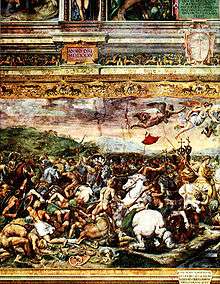
However, the system broke down very quickly thereafter. When Constantius died in 306, Galerius promoted Severus to Augustus while Constantine, Constantius' son, was proclaimed Augustus by his father's troops. At the same time, Maxentius, the son of Maximian, who also resented being left out of the new arrangements, defeated Severus before forcing him to abdicate and then arranging his murder in 307. Maxentius and Maximian both then declared themselves Augusti. By 308 there were therefore no fewer than four claimants to the rank of Augustus (Galerius, Constantine, Maximian and Maxentius), and only one to that of Caesar (Maximinus).
In 308 Galerius, together with the retired emperor Diocletian and the supposedly retired Maximian, called an imperial "conference" at Carnuntum on the River Danube. The council agreed that Licinius would become Augustus in the West, with Constantine as his Caesar. In the East, Galerius remained Augustus and Maximinus remained his Caesar. Maximian was to retire, and Maxentius was declared a usurper. This agreement proved disastrous: by 308 Maxentius had become de facto ruler of Italy and Africa even without any imperial rank, and neither Constantine nor Maximinus—who had both been Caesares since 306 and 305 respectively—were prepared to tolerate the promotion of the Augustus Licinius as their superior.
After an abortive attempt to placate both Constantine and Maximinus with the meaningless title filius Augusti ("son of the Augustus"), essentially an alternative title for Caesar), they both had to be recognised as Augusti in 309. However, four full Augusti all at odds with each other did not bode well for the tetrarchic system.
Between 309 and 313 most of the claimants to the imperial office died or were killed in various civil wars. Constantine forced Maximian's suicide in 310. Galerius died naturally in 311. Maxentius was defeated by Constantine at the Battle of the Milvian Bridge in 312 and subsequently killed. Maximinus committed suicide at Tarsus in 313 after being defeated in battle by Licinius.
By 313, therefore, there remained only two emperors: Constantine in the West and Licinius in the East. The tetrarchic system was at an end, although it took until 324 for Constantine to finally defeat Licinius, reunite the two halves of the Roman Empire and declare himself sole Augustus.
Emperors
| Portrait | Name | Reign | Co-ruler(s) | Ref |
|---|---|---|---|---|
_-_Foto_G._Dall'Orto_28-5-2006.jpg) |
Diocletian
CAIVS AVRELIVS VALERIVS DIOCLETIANVS (Whole, then East) |
20 November 284–
1 May 305 (20 years, 5 months and 11 days) |
Maximian (Caesar, 21 July 285–1 April 286; co-Augustus, 286–1 May 305)
Galerius (Caesar, 21 March 293–1 May 305) Constantius I Chlorus (Caesar, 1 March 293–1 May 305) |
[6] |
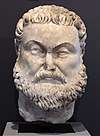 |
Maximian
MARCVS AVRELIVS VALERIVS MAXIMIANVS HERCVLIVS (West) |
1 April 286 – 1 May 305
(retired) end 306/early 307 – November 308 (19 years and 1 month) |
Diocletian (Augustus, 21 July 285; co-Augustus, 1 April 286–1 May 305)
Galerius (Caesar, 21 March 293–1 May 305) Constantius I Chlorus (Caesar, 1 March 293–1 May 305) Maxentius (Caesar, 28 October 306; junior co-Augustus, April 307–November 308) Constantine I (rival Augustus, 25 July 306; proclaimed junior co-Augustus by Maximian, c. late summer 308) |
[6] |
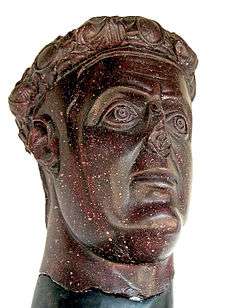 |
Galerius
CAIVS GALERIVS VALERIVS MAXIMIANVS (East) |
1 May 305–
5 May 311 (6 years and 4 days) |
Diocletian (Augustus, 21 March 293–1 May 305)
Maximian (Augustus, 21 March 293–1 May 305) Constantius I Chlorus (Caesar, 1 March 293; co-Augustus, 1 May 305–25 July 306) Valerius Severus (Caesar, 1 May 305; co-Augustus, August 306–April 307) Maxentius (Caesar, 28 October 306; junior co-Augustus, April 307–May 311) Licinius (designated Augustus for the West, 11 November 308–311) Maximinus II (Caesar, 1 May 305; co-Augustus, 1 May 310–early May 311) |
[6] |
 |
Constantius I Chlorus
MARCVS FLAVIVS VALERIVS CONSTANTIVS HERCVLIVS (West) |
1 May 305–
25 July 306 (1 year, 2 months and 24 days) |
Diocletian (Augustus, 1 March 293–1 May 305)
Maximian (Augustus, 1 April 286–1 May 305) Galerius (Caesar, 21 March 293; co-Augustus, 1 May 305–25 July 306) Valerius Severus (Caesar, 1 May 305 –July 306) Maximinus II (Caesar, 1 May 305–25 July 306) |
[6] |
.jpg) |
Valerius Severus
(also Severus II) FLAVIVS VALERIVS SEVERVS (West) |
25 July 306 – April 307
(<1 year) |
Galerius (Augustus, 25 July 306–April 307)
Maxentius (Caesar, 28 October 306; rival Augustus, c. April 307) Constantine I (rival Augustus, 25 July 306–April 307) Maximinus II (Caesar, 1 May 305–April 307) |
[6] |
.jpg) |
Constantine I the Great
FLAVIVS VALERIVS AVRELIVS CONSTANTINVS (West) |
25 July 306–
18 September 324 (18 years, 1 month and 25 days; later emperor of the entire empire 324–337) |
Maximian (rival Augustus, late 306; senior co-Augustus, c. late summer 308–November 308)Maxentius (Caesar, 28 October 306; rival Augustus, c. April 307–28 October 312)
Licinius (rival Augustus, 11 November 308–312; co-Augustus, 313–314; rival Augustus, 314–317; co-Augustus, 317–321; rival Augustus, 321–19 September 324) Crispus (Caesar, 1 March 317–324) Constantine II (Caesar, 1 March 317–324) Martinian (rival Augustus, 324) |
[6] |
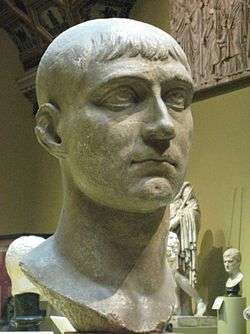 |
Maxentius
MARCVS AVRELIVS VALERIVS MAXENTIVS (West) |
28 October 306–
28 October 312 (6 years) |
Maximian (co-Augustus, 306–308)
Valerius Severus (rival Augustus, August 306–April 307) Licinius (rival-Augustus, 11 November 308–28 October 312) Constantine I (rival Augustus, 25 July 306–28 October 312) |
[6] |
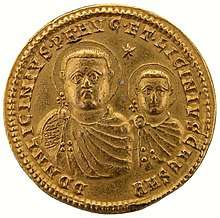 |
Licinius
CAIVS VALERIVS LICINIANVS LICINIVS (West, then East) |
11 November 308–
19 September 324 (15 years, 10 months and 8 days) |
Constantine I (rival Augustus, 11 November 308–312; co-Augustus, 313–314; rival Augustus, 314–317; co-Augustus, 317–321; rival Augustus, 321–19 September 324)
Valerius Valens (designated Augustus for the West, 316–317) Licinius II (Caesar, 1 March 317–324) Crispus (Caesar, 1 March 317–324) Constantine II (Caesar, 1 March 317–324) Martinian (designated Augustus for the West, 324) |
[6] |
 |
Maximinus II Daia
CAIVS CALERIVS VALERIVS MAXIMINVS (East) |
1 May 310 – summer 313
(2 years) |
Constantius I Chlorus (Augustus, 1 May 305–25 July 306)
Galerius (Augustus, 1 May 305–25 July 311) Valerius Severus (Caesar, 1 May 305–July 306) Maximian (Augustus, late 306–November 308) Maxentius (rival Caesar, 28 October 306; Augustus, c. April 307; rival Augustus, 1 May 310–28 October 312) Constantine I (Augustus, 25 July 306; rival Augustus, 1 May 310–313) Licinius (Augustus, 11 November 308; rival Augustus, 1 May 310–313) |
[6] |
Detailed timeline
| Diarchy 21 July 285 - 1 March 293 | |||
|---|---|---|---|
| Western Roman Empire | Eastern Roman Empire | ||
| Augustus Maximian (250-310) |
Augustus Diocletian (244-311) | ||
| Usurpers (date) | |||
| Carausius (286-293) Roman Britain | |||
| First Tetrarchy 1 March 293 - 1 May 305 | |||
|---|---|---|---|
| Dioceses of Spain, Italy and Africa | Dioceses of the East, Asia and Pontus | ||
| Augustus Maximian (250-310) |
Augustus Diocletian (244-311) | ||
| Dioceses of Gaul, Vienne and Britain | Dioceses of Pannonia, Moesia and Thrace | ||
| Caesar Constantius Chlorus (250-306) |
Caesar Galerius (250-311) | ||
| Usurpers (date) | |||
| Carausius (286-293) Roman Britain Allectus (293-296) Roman Britain |
Domitius Domitianus (297) Roman Egypt Achilleus (297-298) Roman Egypt | ||
| Second Tetrarchy 1 May 305 - 25 July 306 | |||
|---|---|---|---|
| Dioceses of Gaul, Vienne, Spain and Britain[7] | Dioceses of Pannonia, Moesia, Thrace, Pontus and Asia[7] | ||
| Augustus Constantius Chlorus (250-306) |
Augustus Galerius (250-311) | ||
| Dioceses of Italy and Africa[7] | Dioceses of the East[7] | ||
| Caesar Valerius Severus (?-307) |
Caesar Maximinus Daia (270-313) | ||
| Third Tetrarchy 25 July 306 - 16 August 307 | |||
|---|---|---|---|
| Dioceses of Italy, Africa, Hispania and Pannonia[7] | Dioceses of Moesia, Macedonia, Thrace, Pontus and Asia[7] | ||
| Augustus Valerius Severus (?-307) |
Augustus Galerius (250-311) | ||
| Dioceses of Britain, Vienne and Gaul[7] | Diocesis of the East[7] | ||
| Caesar Constantine I (272-337) |
Caesar Maximinus Daia (270-313) | ||
| Usurpers (date) | |||
| Augustus Maxentius (306-312) firstly Rome, then Italy and Africa Augustus Maximian (306-309) Italy and Africa | |||
| Fourth Tetrarchy 16 August 307 - May 311 | |||
|---|---|---|---|
| Dioceses of Gaul, Vienne, Hispania and Britain | Dioceses of Moesia, Macedonia, Thrace, Pontus and Asia | ||
| Augustus Constantine I (272-337) |
Augustus Galerius (250-311) | ||
| Dioceses of Pannonia | Dioceses of the East | ||
| Augustus Licinius (250-325) |
Augustus Maximinus Daia (270-313) | ||
| Dioceses of Italy and Africa | |||
| Augustus Maxentius (306-312) Augustus Maximian (306-309) He broke with his son and took refuge in Arles under protection of Constantine. He later rebelled against Constantine and was compelled to commit suicide in 310 | |||
| Usurpers(date) | |||
| Domitius Alexander (309-311) in Africa against Maxentius | |||
| Fifth Tetrarchy May 311 - August 313 | |||
|---|---|---|---|
| Dioceses of Gaul, Vienne, Hispania, Britain (Italy and Africa)[8] | Dioceses of Pannonia, Moesia, Macedonia and Thrace (Asia, Pontus and of the East)[9] | ||
| Augustus Constantine I (272-337) |
Augustus Licinius (250-325) | ||
| Dioceses de Italy and Africa | Dioceses de Asia, Pontus and of the East | ||
| Augustus Maxentius (306-312) |
Augustus Maximinus Daia (270-313) | ||
| Last Tetrarchy August 313 - 18 September 324 | |||
|---|---|---|---|
| Dioceses of Gaul, Vienne, Hispania, Britain, Italy and Africa (Pannonia, Moesia and Macedonia)[10] |
Dioceses of Pannonia, Moesia, Macedonia, Thrace, Asia, Pontus and of the East | ||
| Augustus Constantine I (272-337) |
Augustus Licinius (250-325) | ||
| Western Roman Empire | Eastern Roman Empire | ||
| Caesar Crispus (305-326) he was proclaimed by his father Constantine in 317 Caesar Constantine II (317-337) he was proclaimed by his father Constantine in 317 |
Augustus Valerius Valens (?-317) co-emperor with Licinius in Pannonia, elevated as Augustus by Licinius, but he had Valens executed Caesar Licinius II (316-326) he was raised to the rank of Caesar by his father Licinius in 317 Augustus Martinianus (?-325) nominal co-emperor with Licinius in 324 | ||
Simplified timeline
Tetrarchy until 1 May 305
| West | East | |
|---|---|---|
| Augusti | Maximian | Diocletian |
| Caesares | Constantius Chlorus | Galerius |
Tetrarchy until July 306
After the retirement of the two Augusti both previous Caesares succeeded them, and two new Caesares were appointed. Maximinus Daia was Galerius' nephew.
| West | East | |
|---|---|---|
| Augusti | Constantius Chlorus | Galerius |
| Caesares | Severus | Maximinus Daia |
Tetrarchy until 16 May 307
After the death of Constantius his legions proclaim his son Constantine the new Augustus, but Galerius elevates Severus to be the new junior Augustus and compensates Constantine with the rank of Caesar.
| West | East | |
|---|---|---|
| Augusti | Severus | Galerius |
| Caesares | Constantine | Maximinus Daia |
Tetrarchy from 18 November 308 to the beginning of May 311
After the death of Severus, Constantine does not succeed him. At the council of Carnutum, Diocletian decides that Licinius will be the new Augustus of the West.
| West | East | |
|---|---|---|
| Augusti | Licinius | Galerius |
| Caesares | Constantine | Maximinus Daia |
Tetrarchy from May 311
After the death of Galerius he was succeeded by Maximinus Daia in as Augustus of the East, but is crowded by Licinius, who wants to have the status of the senior Augustus. Maximinus appoints no new Caesar, although it was assumed that this position should later on be filled out with the son of Severus, Flavius Severianus, or at least that he was scheduled for this position.
| West | East | |
|---|---|---|
| Augusti | Licinius | Maximinus Daia |
| Caesares | Constantine | vacant |
Tetrarchy after 8 October 316 to the end of 316
Shortly before the turn of the year 316/317, Constantine, now Augustus in the West, appointed a Caesar, while Licinius briefly appointed one of his officers, Valerius Valens, as the third Augustus. This was apparent from coins, though Valens was apparently inferior to Licinius, who soon executed him. Even the chronology is unclear, as the date stamping could also be the turn of the year 314/315.
| West | East | |
|---|---|---|
| Augusti | Constantine | Licinius and Valerius Valens |
| Caesares | Bassianus |
Tetrarchy from 1 March 317 to 18 September 324
The tetrarchic system is at its end. Both Augusti appoint their own sons as co-emperors, restoring a dynastic system. However, before his death, Licinius appoints the General Martinianus on 3 July 324 as Augustus in name only, as Martinianus was intended to replace Constantine in the west.
| West | East | |
|---|---|---|
| Augusti | Constantine I | Licinius |
| Caesares | Crispus and Constantine II | Licinius II |
Legacy
Although the tetrarchic system as such only lasted until 313, many aspects of it survived. The fourfold regional division of the empire continued in the form of Praetorian prefectures, each of which was overseen by a praetorian prefect and subdivided into administrative dioceses, and often reappeared in the title of the military supra-provincial command assigned to a magister militum.
The pre-existing notion of consortium imperii, the sharing of imperial power, and the notion that an associate to the throne was the designated successor (possibly conflicting with the notion of hereditary claim by birth or adoption), was to reappear repeatedly.
The idea of the two halves, the east and the west, re-emerged and eventually resulted in the permanent de facto division into two separate Roman empires after the death of Theodosius I, though it is important to remember that the empire was never formally divided, the emperors of the eastern and western halves legally ruling as one imperial college until the fall of Rome's western empire left Byzantium, the "second Rome", sole direct heir.
Other examples
| Part of a series of articles on |
| Monarchy |
|---|
.svg.png) |
|
Central concepts |
|
History
|
| Politics portal |
- Tetrarchies in the ancient world existed in both Thessaly (in northern Greece) and Galatia (in central Asia Minor; including Lycaonia) as well as among the British Cantiaci.
- The constellation of Jewish principalities in the Herodian kingdom of Judea was known as a tetrarchy; see Tetrarchy (Judea).
- In the novel The Lion, the Witch and the Wardrobe, the Pevensie siblings rule Narnia as a tetrarchy of two kings and two queens.
See also
- Notitia dignitatum, a later document from the imperial chancery
- Problem of two emperors – A problem arising when multiple people claim the title of emperor
Notes
- Historian David Potter translates the term as "gang of four". See idem., Constantine the Emperor (Oxford: Oxford University Press, 2013), 1.
Citations
- Qtd. and tr. Leadbetter, Galerius, 3.
- Amm. Marc. 14.11.10; Jul. Caes. 315A-B.
- Leadbetter, Galerius, 3.
- Leadbetter, Galerius, 3–4.
- The chronology has been thoroughly established by Kolb, Diocletian, and Kuhoff, Diokletian.
- Cooley, Alison E. (2012). "Imperial titles, Augustus–Justinian (Appendix 2)". The Cambridge Manual of Latin Epigraphy. pp. 488–509. doi:10.1017/cbo9781139020442.007. Retrieved 2020-06-26.
- Bajo, F. (1990) Constantino y sus sucesores. La conversión del Imperio. Akal Historia del mundo antiguo, pág 9
- after defeating Maxentius in 312
- A partir de derrotar a Maximino Daya
- After defeating Licinius in 317
References
- Barnes, Timothy D. (1984). Constantine and Eusebius. Harvard University Press. ISBN 0-674-16531-4.
- Bowman, Alan (2005). The Cambridge Ancient History Volume 12, The Crisis of Empire, AD 193–337. Cambridge University Press. ISBN 0-521-30199-8.
- Corcoran, Simon (2000). The Empire of the Tetrarchs, Imperial Pronouncements and Government AD 284–324. Oxford University Press. ISBN 0-19-815304-X.
- Kolb, Frank (2011-07-11). Diocletian und die Erste Tetrarchie: Improvisation oder Experiment in der Organisation monarchischer Herrschaft? (in German). Berlin: de Gruyter. ISBN 9783110846508.
- Kuhoff, Wolfgang (2001). Diokletian und die Epoche der Tetrarchie: Das römische Reich zwischen Krisenbewältigung und Neuaufbau (284-313 n. CHR.). Frankfurt am Main: Lang. ISBN 9783631367926.
- Leadbetter, William Lewis (2009-12-04). Galerius and the Will of Diocletian. London, New York: Routledge. ISBN 9781135261320.
- Rees, Roger (2004). Diocletian and the Tetrarchy. Edinburgh, UK: Edinburgh University Press. ISBN 9780748616602.CS1 maint: ref=harv (link)
External links
| Wikimedia Commons has media related to Tetrarchy. |
- A detailed chronology of the tetrarchy from Diocletian to Constantine
- A chart showing the tetrarchy from Diocletian to Constantine